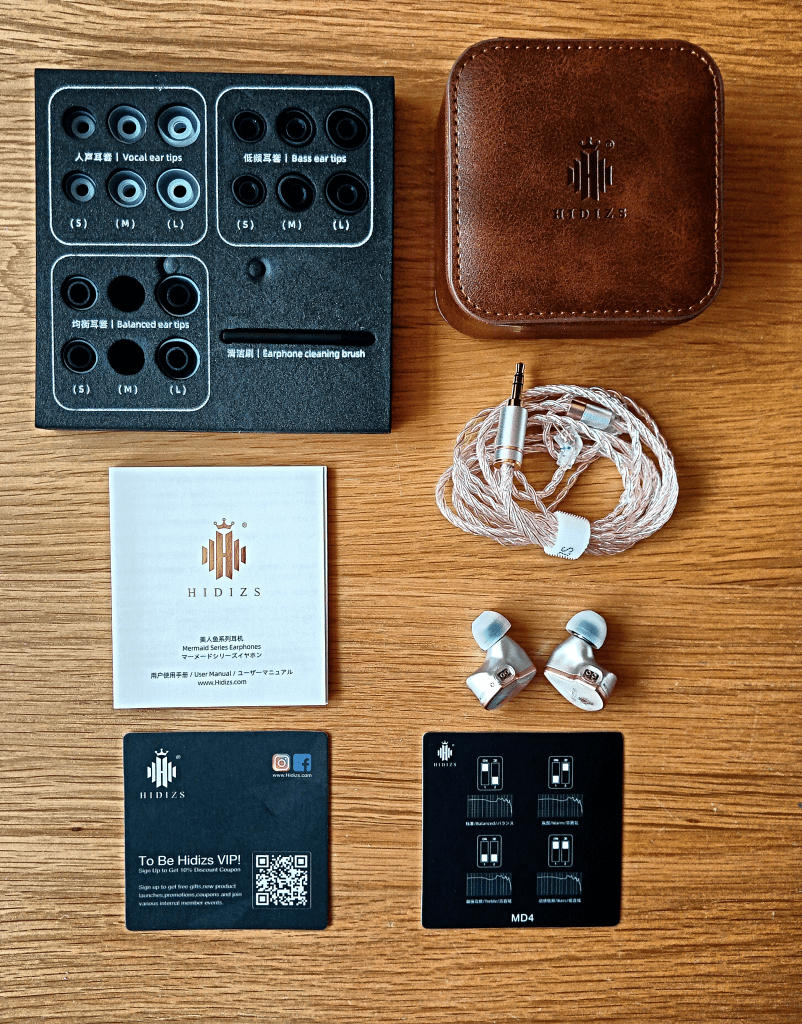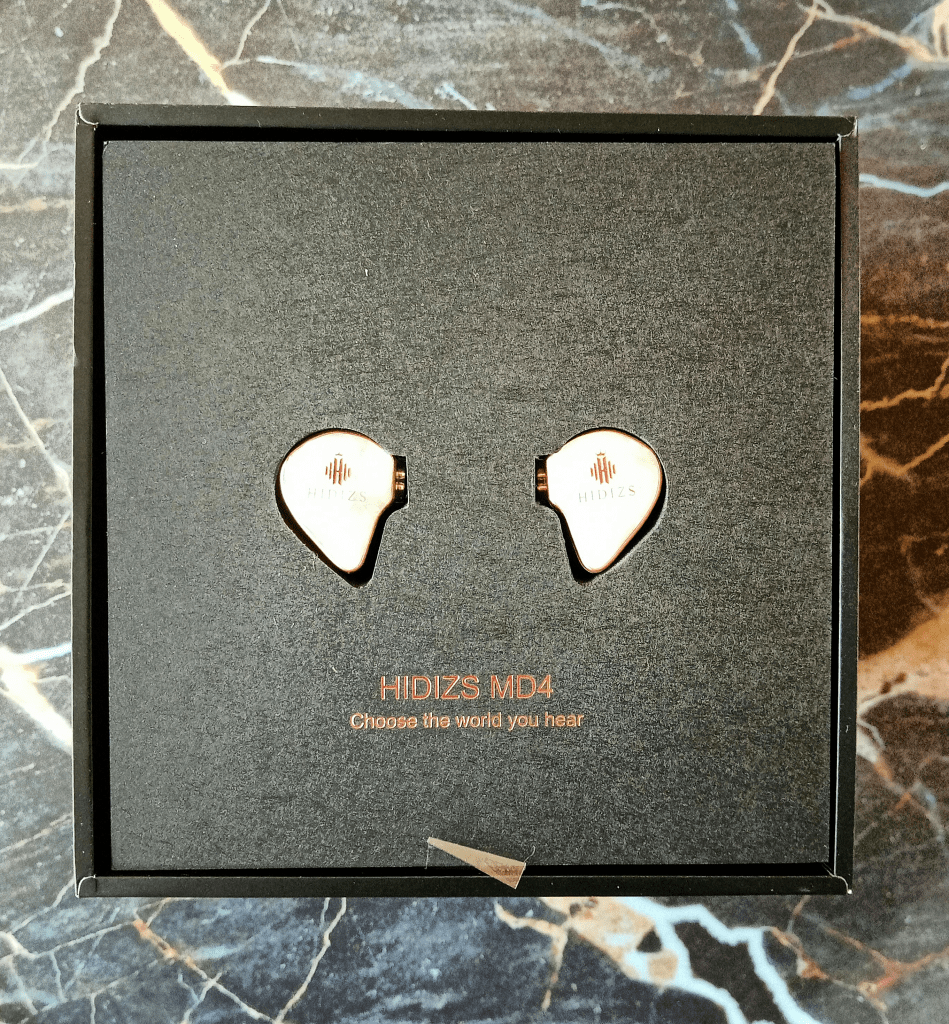Hidizs, founded in 2009, is perhaps best known for the compact and high performance AP80 DAP. However the company also has a range of other products including the Mermaid series of IEMs. The MD4 is the latest model in the collection which includes the MM2 (1DD + Magnetostatic), MS2 (1DD + 1BA) and MS4 (1DD + 3BA).

The Packaging
The MD4 comes in a cube-shaped black box with a full-colour image of the IEMs on the front, Hidizs branding and a Hi-Res Audio logo. Specifications and product details are printed on the underside. Removing the lid, the earpieces are presented in a cut-out with the model name and legend “Choose the world you hear” below.
Under this is a further layer with the spare ear tips and cleaning brush. Finally in the lowest layer you will find the faux leather case in which the 2-pin cable is stored. In all the box contains:
- Hidizs MD4 IEMs
- 2-pin hybrid 4-core cable with 3.5mm plug
- “Vocal” silicone tips (S, M, L)
- “Balanced” silicone tips (S, M, L)
- “Bass” silicone tips (S, M, L)
- Cleaning brush
- Faux leather case
- Documentation

Build and Design
The MD4 is a quad-driver all-BA model with two bass drivers, one midrange driver and one treble unit and a 3-way crossover. The BAs are described as “custom-designed balanced armatures”. The earpieces are formed from CNC milled aluminium alloy and are smoothly contoured with no sharp edges. My particular example was silver in colour (black and blue are also available).
The celluloid faceplate has a pearl finish with a rose gold border and there is a Hidizs logo with the brand name below. The nozzle is metal and the 2-pin sockets are recessed with a clear plastic surround, next to which L & R channel indication is marked. The twin tuning switches, providing four different tuning options, are on the rear of the earpieces.

The cable is a 4-core design with two high purity silver wires and two OFC copper wires. It has a straight 3.5mm plug with Hidizs branding and is finished in silver and rose gold to match the faceplate of the IEMs. There is a rose gold coloured chin slider and the metal Y-split is coloured silver.
The plastic 2-pin plugs are angled with channel identification provided by a red dot for the right channel and a blue dot for the left. The cable is a little prone to tangling but the ear guides are supple and comfortable and the connection was very secure.
Fit and Isolation
The MD4 was very comfortable in use, the earpieces fitting snugly in the ears. Isolation was above average with most external sounds inaudible when playing music and I would consider them eminently suitable for on-stage monitoring.
Sound Impressions
The MD4 was auditioned with an Xduoo X20 DAP and the Hidizs AP80 Pro X. Initially, the stock cable and the pre-fitted medium “Balanced” tips were used, but after some experimentation I found the medium “Bass” tips to give the best sound balance although of course this will vary according to individual ear anatomy. A burn in period of 100 hours was carried out.
Tonality
The first impression was of a highly detailed and bright profile with a forward midrange, a neutral bass and clear well-articulated treble. There was an emphasis in the upper midrange and lower treble and there was a rather steep roll off in the higher frequencies which slightly unbalanced the presentation.
However this was improved by using the “bass” tips and was further reduced when switching from the X20 to the AP80 Pro X DAP, and this was the configuration used for the remainder of the review. I did find the MD4 a little power-hungry and it benefited both from amplification and balanced output, for which a Yinyoo 2.5mm balanced cable was used.
Bass
The MD4’s bass was quick, detailed and tight with good resolution, as might be expected from balanced armature drivers. The textures in the low frequencies were particularly well defined. Although neutral in character, there was some sub-bass presence, though not in sufficient quantity to satisfy bass lovers, and even with the “bass” setting of the switches, a little more weight to the notes would have been welcome.
Orchestral bass drums and timpani showed a crisp and fast leading edge, a natural timbre and realistic decay. The mid-bass was punchy and agile with good definition and tonality, bass guitars displaying a satisfying “growl” and impact. The transition to the midrange was clean with no evidence of bass bleed.
Midrange
The MD4’s midrange was forward in nature, bright and detailed with excellent transparency. It was simple to follow individual strands in the music with orchestral counterpoint clearly depicted and vocals stood out prominently from their accompaniment with lyrics easily discernible.
The forward nature of the presentation did impact on the staging which suffered a lack of depth, especially during busy and energetic passages and there was a mild emphasis in the upper region which occasionally resulted in an unnatural timbre. Imaging and separation were above average, largely due to the copious detail. The elevated response was maintained into the treble region.
Treble
The treble continued elevated from the boundary of the midrange. After this there was a dip, a further rise and then a rather steep roll off. There was still a good level of detail but the timbre was at times a little sharp. The roll-off resulted in a lack of air and a more restricted staging which tended to flatten at high volume.
At normal levels, though, the sound was clear, clean and precise. I did notice that the MD4 showed up poor recordings and really thrived with high quality material when the above issues were not as evident. There was also further improvement with extra power.
When run balanced or with additional amplification the high frequencies became smoother and more open in character. The MD4 is a bright IEM by nature and needs a little TLC to extract the best from it.

Soundstage and Imaging
The soundstage displayed good width, extending a little beyond the ears, and lateral imaging was very good with movement well rendered. The impression of height was also good but there was a reduction in depth and perspective due to the forward midrange and bright treble which tended to compress the image.
Layering and separation were more effective because of the level of detail and clarity available. When used with additional amplification or via a balanced output, the stage expanded and improved in all respects.
Tuning Switches
The four tuning options provide subtle variations of the basic tonality. The changes mainly affect the treble levels and consequently the overall balance. The impressions above were made using the “Balanced” setting. Here are the effects I found with the other switch positions:
“Bass”
In this setting I noticed a reduction in treble output and a minor recession in the midrange, resulting in a mild V or U shape giving the impression of more bass. There certainly was a little more warmth here but at the same time, the detail and clarity were reduced.
“Warm”
This setting appeared to cut the treble a little more than the Bass position and the sense of attack was softened. The midrange came over less forcefully with an overall more relaxed feeling, though once more, the detail was reduced compared to the Balanced mode.
“Treble”
With an enhanced upper range, this setting was brighter and the transient attack restored but as a result, some of the issues with the treble mentioned above were exacerbated, with the sharp timbre returning and the balance of the sound shifted to the high frequencies with a colder tonality resulting. This setting would appeal to treble lovers but was not to my taste.
Comparisons
KZ AST ($125)
The AST is KZ’s flagship model featuring an impressive 12 BAs per channel. In this model, KZ has moved away from the traditional V-shaped tuning of the past and has aimed for a more balanced profile. The AST shares the same fast, dynamic and clean presentation of the MD4, but the lower frequencies have a little more warmth without sacrificing impact or accuracy.
There is extra depth and weight in the AST’s bass which results in an improved balance, whereas the MD4 emphasises the midrange and treble over the bass.
The MD4’s midrange is more prominent with excellent detail retrieval and clarity and as a result the staging is not as deep. The treble is more detailed in the MD4 but is not as smooth in character, being sharper and crisper. The AST is not as extended in the high frequencies but is softer in nature. Soundstage is equal in width and height with the AST being a shade deeper.
Aiderlot M5 ($199)
The M5 is a high quality five-driver IEM using premium Knowles drivers in a four-way configuration. It also features three different tuning nozzles, “Reference”, “Bass” and “Treble”. With the bass nozzles installed, the Aiderlot M5 sounds very similar to the MD4, with a linear bass profile, a midrange which is not recessed and an extended treble with high levels of detail. The MD4 has a little more bass depth and is a touch warmer in character.
The presentation is more analytical than the MD4 with a somewhat cooler tonality but shares the MD4’s clarity and transparency. Soundstage is of similar dimensions, the M5 having a little more depth and the MD4 providing more width with superior imaging. I consider it “honours even” with this pairing and choice would be down to individual preferences although the $30 saving may be a factor in choosing the MD4.
TRI Starsea ($140)
The Starsea is a three-driver design employing an 8mm “composite silicon crystal” DD, Knowles ED29869 midrange BA unit and a TRI Hi-A treble BA.
Like the MD4, the Starsea has two tuning switches providing four different sound profiles “Balanced”, “Amazing Bass”, “Beautiful Vocals” and “Exquisite Pure Tone” . The effects here were more obvious than those in the MD4. All comparisons are made with the “Amazing Bass” setting engaged. The Starsea has a largely neutral and transparent sound.
Bass has some sub bass presence but no mid bass bump and has that DD warmth contrasting with the faster more agile BA bass of the MD4. The MD4 is more linear here, with a cooler tonality but, like the Starsea, does not suffer from bass bleed and also has a smooth transition into the midrange. Here, the Starsea’s Knowles 29869 driver has good timbre, with a warmer feel and is not as forward as the MD4, resulting in a more spacious sound with more depth in the staging.
In the treble, the Starsea’s proprietary TRI “Hi-A” unit delivers a smoother more extended response. Soundstage is also superior in the Starsea, being remarkably open and transparent with excellent layering and separation. The MD4 is more dynamic and bright in character and more “immediate” whereas the Starsea is more relaxed and spacious. These are two quite different presentations.
Conclusion
The MD4 is a solid performer with a neutral/bright profile. When enhanced with additional power or balanced operation and fed with high quality material, it certainly holds its own with other models in its price range and has a crisp, immediate and detailed character. It is, however, quite fussy in partnering sources and needs a little experimentation to extract its potential.
It is very well made, good looking and attractively presented and with its four different sound profiles has versatility to add to its attractions. It is a worthy addition to Hidizs’s range of IEMs and if the fast and clean sound of BAs is your preference it will be a good choice.
Hidizs MD4 Specifications:
- Drivers: 4 BAs (2 x low, 1 x mid, 1 x high)
- Crossover: 3 way
- Impedance: 8 Ohms
- Sensitivity: 102 +/- dB.
- Plug: 3.5 gold-plated plug
